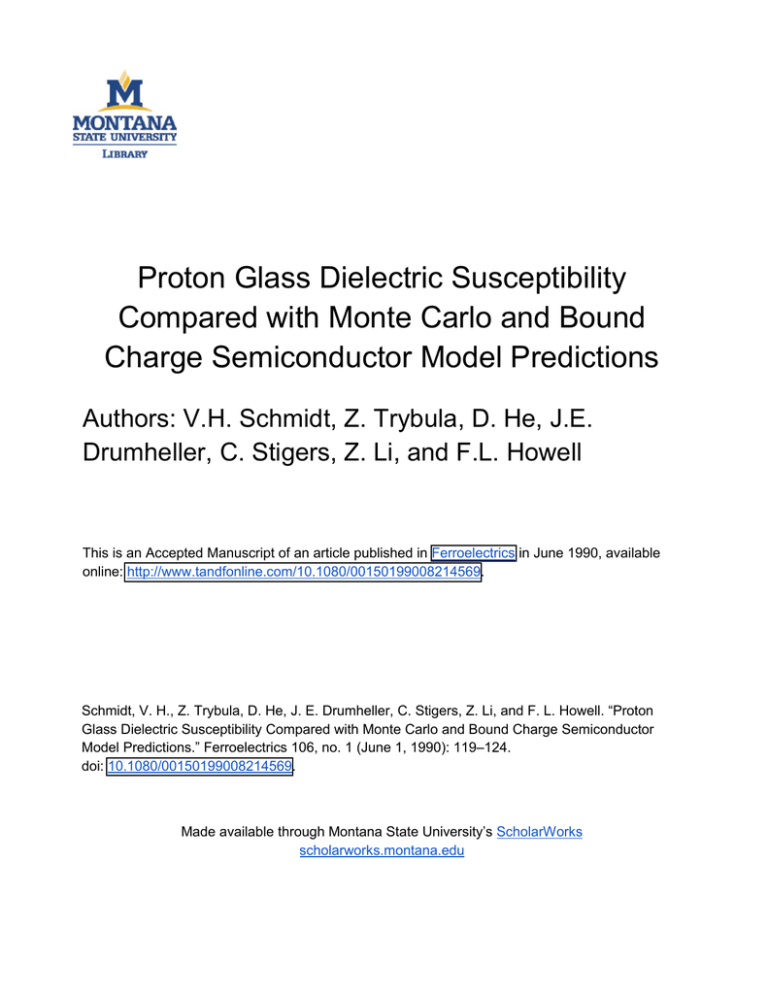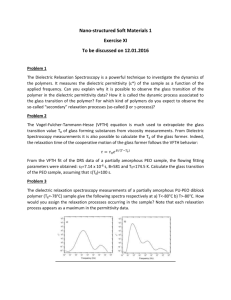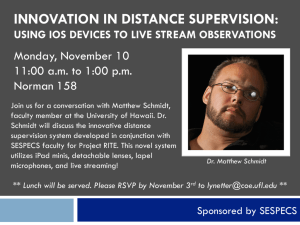Proton Glass Dielectric Susceptibility Compared with Monte Carlo and Bound
advertisement

Proton Glass Dielectric Susceptibility Compared with Monte Carlo and Bound Charge Semiconductor Model Predictions Authors: V.H. Schmidt, Z. Trybula, D. He, J.E. Drumheller, C. Stigers, Z. Li, and F.L. Howell This is an Accepted Manuscript of an article published in Ferroelectrics in June 1990, available online: http://www.tandfonline.com/10.1080/00150199008214569. Schmidt, V. H., Z. Trybula, D. He, J. E. Drumheller, C. Stigers, Z. Li, and F. L. Howell. “Proton Glass Dielectric Susceptibility Compared with Monte Carlo and Bound Charge Semiconductor Model Predictions.” Ferroelectrics 106, no. 1 (June 1, 1990): 119–124. doi: 10.1080/00150199008214569. Made available through Montana State University’s ScholarWorks scholarworks.montana.edu Ferroelecrrics, 1990, Vol. 106, pp. 119-124 Reprints available directly from the publisher Photocopying permitted by license only 0 1990 Gordon and Breach Science Publishers S.A. Printed in the United States of America PROTON GLASS DIELECTRIC SUSCEPTIBILITY COMPARED WITH MONTE CARL0 AND BOUND CHARGE SEMICONDUCTOR MODEL PREDICTIONS V.H. SCHMIDT, Z. TRYBUCA, D. HE, J.E. DRUMHELLER, C. STIGERS, Z. LI, and F.L. HOWELL* Physics Dept., Montana State Univ., Bozeman, MT 59717 *Physics Dept., U. North Dakota, Grand Forks, ND 58202 Abstract Our latest results for dielectric permittivity and loss and protonic conductivity in RADP, RADA and DRADA proton glasses are presented. Improvements in our "bound charge semiconductor" model for dielectric behavior are discussed. Monte Carlo studies of the phase diagram and polarization decay are described. Bias order parameter c. temperature plots from the simulation and from ND, deuteron NMR lineshapes are compared. We describe here our proton glass dielectric measurements, and their interpretation by Monte Carlo simulations based on a short-range-interaction model and by an analytic model €or diffusion of effective charge carriers. We made dielectric measurements on 50% ammoniated rubidium dihydrogen phosphate (RADP) between 93 and 3 4 8 K. The losses in this temperature range are caused by protonic conductivity, which is plotted in Fig. 1. The conductivity is similar to that of other crystals in this family. The inverse permittivity plotted in Fig. 2 gives a straight Curie-Weiss plot for E, near 5. The Curie-Weiss constant is 2800 K, close to the Slater' theory value of = 2700 K. a*~P,~/4ke, Dielectric results are presented also for 20% ammoniated rubidium dihydrogen arsenate (RADA), in Figs. 3 and 4. These show typical proton glass behavior, similar to our results in 35% ammoniated RADA.' However, the 4% ammoniated crystal shows unusual behavior. In Fig. 5 the ferroelectric transition at 80 K is followed by typical proton glass dispersion below 30 K, as seen also in Fig. 6 and in the loss curves of Fig. 7. We believe that local regions with high Rb' concentrations are ferroelectric, while NH,'-rich regions show proton glass behavior. [ 11911955 b0 ' I I I C = 2 8 0 0 i 600 K .. IO'/T FIGURE 1 Conductivity along's of 50150 RADP. 50 r$J &p a OO ,o o o o o 'roo I O=I kHz I 0 = 3 0 hHz 200 I00 T(K) 1 I FIGURE 2 Curie-Weiss behavior of 50150 RADP. 10 300 FIGURE 3 Permittivity along 5 of 80120 RADA. I60 T(K) I 20 T 30 (to FIGURE 4 Loss along of 80120 RADA. a I I I I I20 E: 80 0 00 OQ3 000 L(0 0 FIGURE 5 Permittivity along 5 of 9 6 / 0 4 RADA, showing both ferroelectric transition and dielectric dispersion. YO PROTON GLASS DIELECTRIC SUSCEPTIBILITY ... [ 121]/957 6 0 q E; 2 0 I along I 20 I I YO T (KI I I 60 FIGURE 6 a Permittivity of 9 6 / 0 4 RADA. 0 T 40 IK) FIGURE 7 Loss along of 9 6 / 0 4 RADA. a - T(k) T(K1 FIGURE 8 Permittivity along a of 72/28 DRADA. 20 -a FIGURE 9 Loss along of 72/28 DRADA. [122]/958 V. H. SCHMIDT et al. We made the first dielectric measurements on deuterated rubidium/ammonium dihydrogen arsenate (DRADA), on a 28% ammoniated crystal. The results shown in Figs. 8 and 9 resemble those found by Courtens3 in DRADP, because both DRADA and DRADP show considerable frequency dispersion in this region, while undeuterated RADA and RADP do not. We are analyzing this dielectric behavior in terms of our Ilbound charge semiconductor" model4 I in which polarization change results from drift of HP04 and H3P04 carriers in an effective field which is the sum of the applied and configurational fields. The relaxation time spread results from mobility being a function of time t after step cutoff of an applied dc field. The polarization decay from initial value Pi along the c axis obeys where n is fractional carrier density, To is Curie-Weiss temperature, €4 is rms diffusion step energy change, To is attempt time, and 7 is t for small t and approaches a fixed value for large t. This expression includes the dc susceptibility proposed by Sherrington and Kirkpatrick, in which the bias order parameter q is evaluated using the expression derived by Pirc, Tadib, and Blinc.7 An earlier version of our model8'' gave loss peaks E. temperature which were too broad. In the present model, the power of the logarithm in Eq. (1) is 4 instead of 2, and in its argument t is replaced by 7 which becomes constant at large t. Both changes narrow the range of mobility as t increases, and should fit experiment better. The Monte Carlo simulations are based on a model10,ll employing short-range interactions and random bias. We can simulate polarization decay from a state with initial ferroelectric order (Fig. 10) or antiferroelectric order. To find the Edwards-Anderson order parameter we record a proton configuration,let the system evolve, and find the correlation of the new configuration with the previous one. m~ 2 2-; :: z ?:I P = Seed ":.4 D -= N O BIAS - - - = BIAS FIGURE 11 Monte Carlo determination of phase diagram for a proton glass model, showing phase boundaries with and without a random bias field. 0.V g - $3 ' I 100 RIA~S I T(K1 ORDER'PAR. I 200 FIGURE 12 Monte Carlo determination of bias order parameter for a proton glass model, compared with values found (Ref. 1 2 ) by deuteron NMR artd theory for 5 6 / 4 4 DKADP. V. H. SCHMIDT et al. We find the bias order parameter similarly, but warm and then cool the system so it loses memory of the particular potential minimum it may have been trapped in. To find the phase diagram, we assume the system is in the ferroelectric or antiferroelectric state if it retains 90% of such initial order after a long running time. We found the phase diagram both with and without random bias, as shown in Fig. 11. The bias widens the proton glass concentration range, as expected, because in the NaCN/KCN system which has no frustration, random bias alone produces a phase diagram similar to that of proton glass systems. vs. temperature from We found the bias order parameter our Monte Carlo simulation and compared it to that found from deuteron NMR of ammonium deuterons in DRADP proton glass,” as shown in Fig. 12. The agreement is quite good. In summary, we have shown new dielectric results, particularly for arsenate proton glasses. Our Monte Carlo and bound charge carrier models which are based on the crystal structure and interactions explain these results well. This work was supported by NSF Grant DMR-8714487. [124]/960 REFERENCES 1. J. C. Slater, J. Chem. Phys. 9, 16 (1941). 2. Z. Trybula, V. H. Schmidt, J.-E. Drumheller, D. He, and 2. Li, Phys. Rev. B 4 0 , 5289 (1989). 3. E. Courtens, Phys. Rev. B 33, 2975 (1986). 4. V. H. Schmidt, Bull. Am. Phys. SOC. 34, 827 (1989). 5. V.H. Schmidt, Proc. Ramis Conf., Poznafi (April 1989). 6. D. Sherrington and S. Kirkpatrick, Phys. Rev. Lett. 35, 1792 (1975). 7. R. Pi&, B: TadiC, and R. Blinc, Phys. Rev. B 36, 8607 (1987). 8. V. H. Schmidt, Ferroelectrics 3,207 (1988). 177, 257 (1988). 9. V. H. Schmidt, J. Molec. Struc. 10. V. H. Schmidt, J. T. Wang, and P. T. Schnackenberg, Jpn. J. Appl. Phys. 2 4 , Suppl. 24-2, 944 (1985). 11. V. H. Schmidt, Ferroelectrics 72, 157 (1987). 12. R. Blinc, J. Dolinsek, V. H. Schmidt, and D. C. Ailion, Europhys. Lett. 5, 55 (1988).



